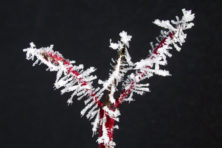Frost Crystals
- Share
- Tweet
- Pin
- Share
Every year when the “first of this” or the “first of that” occurs, I like to think back into previous years, for example during the first week of February, to try to recall what was of importance then.
Here is what came to mind when I wrote this story during the first week of Feb. 1978, 36 years ago: “The eight-inch snowfall that blanketed this area Dec. 24, 1977, had more than one pleasant side effect. A fascinating discovery occurred when I swept the fine snow off the windshield of the van.
There, just waiting to be appreciated, were hundreds of delicate ice flowers and dainty white “Tannenbaums” formed in their matchless tracery on the inner surface of the glass. Our good friend, Jack Frost, had produced another artistic masterpiece. Apparently the amount of trapped water vapor and the subtle changes of air temperature had been ideal during the night.
Frost forms best outdoors or in unheated rooms. Fortunately for us, water vapor is invisible. We can see it only in its liquid or solid state. When the water content of the air is low, such as in winter, one’s lips and hands easily become chapped. In fact there is about six times more moisture present at 86 degrees F. than at 32 degrees F.
One of my most memorable experiences as a youngster was awakening on a sub-zero morning in the large upstairs bedroom (the boys’ bedroom we called it) where I slept with my three brothers, Ivan, Leo and Richard. What I learned from my Dad in later years was that, after we boys were asleep and snug beneath plenty of blankets, he would sneak into our bedroom and close the hot-air register.
We awoke to find the three windows covered with crystalline forms, fairy forests of graceful hemlocks, spruces and firs, ferns and snow castles and all sorts of other imaginary treasures. We were never satisfied until we had pressed the tips of our tongues to the frosty scenes in order to melt tiny windows to the outdoor world.
Today (1978, when this story was written), living as close to Lake Michigan as we do (about 1,200 feet away), we occasionally awaken to find nearly everything in sight outdoors coated with hoarfrost. This is formed by the passing of the invisible water vapor of the atmosphere into the ice crystal phase without going through the liquid state.
One of the most elegant displays of plate-like hoarfrost took place in this region in February 1977. This unusual form of frost usually occurs in midwinter at low temperatures. Weeds, barbed wire fences, shrubs, trees, everything was trimmed with fragile, jagged, nickel- to quarter-sized flat pointed discs of frost. I was so carried away with the astounding display that I came very close to freezing my fingers as I handled my icy cold cameras, snapping one picture after another. I had to be careful to not let the cameras and film get too cold.
I wonder what people thought that day in February 1978 as they drove by and saw me balanced like a contortionist near the top of the stepladder in front of our van’s windshield. What they probably couldn’t see was my camera and that I was photographing the perfectly formed window-glass frost. The temperature and light conditions were just right and I wasn’t about to miss that chance.
I know that someone, were he still living and within sight, would have clapped his hands in approval, Wilson W. Bentley (Snowflake Bentley). This bachelor farmer-meteorologist (weather scientist) from Jericho, VT, became world famous for his photographs of snowflakes taken through a microscope. Jericho is situated in northwest Vermont, about 12 miles east of Lake Champlain in the foothills of the Green Mountains where it is not uncommon to receive 120 inches of snow in one winter.

Jack Frost decorated the inside of our van windows with elegant fern-like designs.
Snowflake Bentley, as his friends called him, just might have been a genuine individualist. Bored with school at an early age he dropped out and his mother tutored him at home. He became quite an expert on the ferns of that region, learned to play the piano very well, and finally was turned on to his lifelong study of snowflakes, frost, etc., when at 15 years of age he received a microscope for Christmas.
A favorite winter book in our library, Snow Crystals by W.A. Bentley and W. J. Humphreys, published now by Dover Publishing Company, consists of 2,453 illustrations chosen from the 6,000 or more pictures of the bewildering variety of snowflakes and related formations Snowflake Bentley took.
One surely does not have to learn the technical and scientific aspects of frost in order to enjoy it; in fact I’m quite satisfied to give credit to “Jack.” Better yet it might be the work of the gnomes during the night when we human beings are snoring.
My wife and I were recently introduced to the beautiful and whimsical world of the gnomes through a book we received for Christmas. (We, too, love to give books as presents because they are gifts which can be opened again and again.)
The title of this truly great book is Gnomes. Its extremely charming and well-done pictures were produced by Rien Poortvliet, Holland’s most popular illustrator. The captivating text was written by Wil Huygen. It is published by Harry N. Abrams, Inc. of New York.
Every now and then life becomes far too serious and fast-paced to the point where a person has to allow his sense of imagination to help ease the tension. In other words, I’m perfectly content to let Jack Frost and his friends the gnomes decorate the windshield of our car, parked outside at night, and chances are pretty good that I’ll be teetering near the top of a stepladder the following morning, enjoying and photographing their art work!



